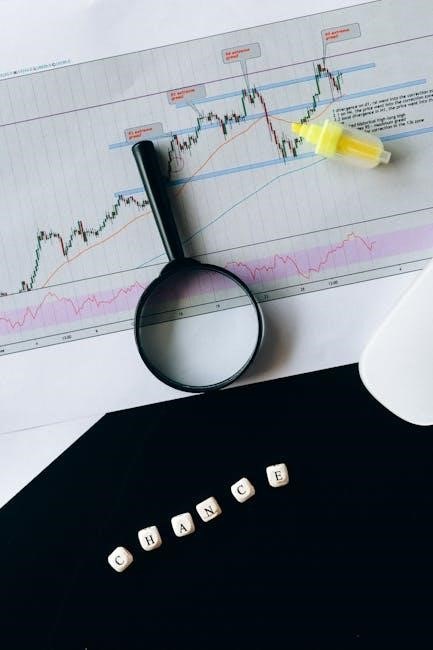
Chart patterns are essential tools in technical analysis, helping traders predict price movements by identifying shapes formed by market data. These patterns, such as head and shoulders or double tops, reveal market psychology and potential trends. Learning these formations can significantly enhance trading strategies, offering insights into profitable opportunities. With resources like “Chart Patterns Cheat Sheet” and works by Thomas Bulkowski, traders can master these techniques to improve their earnings. These patterns are widely used across stocks, forex, and commodities, making them indispensable for both beginners and experienced traders.
Overview of Technical Analysis and Chart Patterns
Technical analysis is a methodology used to predict price movements by studying historical market data, primarily through charts. Chart patterns are graphical representations of price behavior, revealing underlying market psychology and potential trends. These patterns, such as head and shoulders or double tops, are formed by the collective actions of buyers and sellers. They are widely used in stocks, forex, and commodities to identify profitable trading opportunities. By recognizing these formations, traders can anticipate reversals or continuations in price trends. Chart patterns are classified into reversal and continuation patterns, each offering unique insights into market dynamics. Resources like “Chart Patterns Cheat Sheet” and works by Thomas Bulkowski provide detailed guidance on mastering these techniques. Understanding these patterns is crucial for traders aiming to enhance their strategies and improve profitability.

Most Profitable Chart Patterns
Head and shoulders, double tops, cup and handle, wedges, triangles, rectangles, and island reversals are among the most profitable chart patterns, offering high reliability across markets.

Head and Shoulders Pattern
The head and shoulders pattern is one of the most recognizable and reliable reversal patterns in technical analysis. It forms when a stock’s price action creates a peak (head) followed by two lower peaks (shoulders) on either side. This pattern typically signals the end of an uptrend and the potential start of a downtrend. The neckline, drawn through the lows of the pattern, acts as a critical support level. A break below this neckline confirms the reversal, offering traders a profitable entry point. The head and shoulders pattern is widely used across various markets, including stocks, forex, and commodities, making it a cornerstone of many trading strategies. Its effectiveness has been highlighted in numerous resources, including “Chart Patterns Cheat Sheet” and works by Thomas Bulkowski, reinforcing its importance in identifying high-probability trades. By mastering this pattern, traders can significantly enhance their profitability and risk management. Additionally, combining the head and shoulders pattern with other indicators, such as support and resistance levels, can further improve its reliability and success rate in different market conditions. This pattern’s popularity stems from its clear visual structure and consistent performance, making it a favorite among both novice and experienced traders seeking to capitalize on market reversals.
Double Tops and Double Bottoms
Double tops and double bottoms are highly profitable reversal patterns that signal potential trend changes. A double top forms when a stock reaches a peak, declines, rises back to a similar peak, and then declines again. Conversely, a double bottom occurs when a stock drops to a low, rises, falls back to a similar low, and then rises. These patterns are easy to identify and appear frequently in various markets, including stocks, forex, and commodities. The neckline or support/resistance line is a critical component, as a break below (for double tops) or above (for double bottoms) confirms the reversal. These patterns are reliable indicators of market psychology, offering traders clear entry and exit points. They are widely discussed in resources like the “Chart Patterns Cheat Sheet” and are favored by both novice and experienced traders for their simplicity and effectiveness. By mastering double tops and double bottoms, traders can capitalize on trend reversals and enhance their profitability. These patterns are also versatile and can be combined with other technical indicators for stronger signals. Their popularity stems from their clear structure and consistent performance across different market conditions, making them indispensable tools for any trader.
Cup and Handle Pattern
The cup and handle pattern is a bullish continuation or reversal pattern that appears frequently in trading charts. It consists of a “cup” formed by a downward trend followed by an upward recovery to the initial price level, resembling the shape of a cup. The “handle” is a smaller downward move that forms after the cup, typically within 1-2 weeks. This pattern is considered reliable when the handle forms near the top of the cup and does not break below the cup’s lowest point. Traders often look for a breakout above the handle’s resistance line, signaling a potential upward movement. The cup and handle pattern is widely recognized and discussed in resources like the “Chart Patterns Cheat Sheet” and is favored for its clear structure and profitability. It is a valuable tool for identifying trend reversals and continuations, making it a popular choice among traders seeking consistent returns.
Wedges (Rising and Falling)
Wedges are a significant chart pattern that signals potential trend reversals or continuations. A rising wedge forms when a security’s price action creates a bullish trend with higher highs and higher lows, but within converging trendlines. This pattern often indicates a reversal, especially if the breakout occurs below the wedge’s support line. Conversely, a falling wedge forms with lower highs and lower lows, also within converging lines, and typically signals a bullish reversal when the price breaks above the resistance line. Both patterns are reliable indicators of market psychology, as they reflect consolidating price action before a breakout. Traders often use wedges to identify potential entry points, as they can signal strong price movements post-breakout. These patterns are widely discussed in resources like the “Chart Patterns Cheat Sheet” and are considered highly profitable when traded correctly.
Triangles (Symmetrical, Ascending, Descending)
Triangles are versatile chart patterns that indicate potential breakouts or trend continuations. A symmetrical triangle forms when a security’s price action creates equal highs and lows, resulting in converging trendlines. This pattern often signals a breakout in either direction, with the direction determined by which side the price breaches. Ascending triangles, characterized by a rising lower trendline and flat upper resistance, typically signal an upcoming bullish breakout. Conversely, descending triangles, marked by a falling upper trendline and flat lower support, often precede a bearish breakdown. These patterns are highly profitable when identified early, as they can lead to significant price movements post-breakout. Traders frequently use triangles to anticipate market shifts, making them a cornerstone in technical analysis strategies, as outlined in resources like the “Encyclopedia of Chart Patterns” by Thomas Bulkowski.
Rectangle Patterns
Rectangle patterns are powerful consolidation formations that occur when a security’s price oscillates between two parallel horizontal lines. These patterns are often seen during periods of indecision in the market, where bulls and bears are evenly matched. A bullish rectangle typically forms during an uptrend, signaling a pause before a potential continuation. Conversely, a bearish rectangle forms during a downtrend, indicating a brief stabilization before a further decline. The breakout or breakdown from these levels often results in a strong price movement, making rectangles highly profitable setups for traders. They are discussed in detail in resources like the “Encyclopedia of Chart Patterns” and are considered reliable indicators of trend continuation.

Island Reversal Pattern
The island reversal pattern is a rare yet powerful formation that signals a significant shift in market direction. It occurs when a price gap is followed by a failed attempt to continue the trend, leaving a small “island” of price action isolated from the main trend. This pattern is often associated with a dramatic change in market sentiment, making it highly profitable when identified correctly. The island reversal is characterized by a gap in one direction, followed by a series of price bars that fail to extend the trend, and then a gap in the opposite direction. Traders consider this pattern reliable when confirmed by high volume, as it indicates a strong reversal signal. It is widely discussed in resources like “Chart Patterns Cheat Sheet” and is favored by experienced traders for its clarity and potential profitability.
How to Increase Profitability with Chart Patterns
Combining chart patterns with support and resistance levels amplifies trading accuracy. Identifying these zones helps traders set precise entry and exit points, maximizing potential gains while minimizing risks. By aligning patterns with key levels, traders can enhance their strategies, leading to more consistent profitability over time.
Combining Patterns with Support and Resistance Levels

Combining chart patterns with support and resistance levels significantly enhances trading strategies. These levels act as critical zones where price action often reverses or accelerates, aligning perfectly with pattern breakouts. For instance, a head and shoulders pattern breaking below the neckline (a resistance level) can confirm a downtrend. Similarly, a cup and handle pattern reaching a support level may signal a strong upward movement. Traders can use these combinations to identify high-probability setups, improving accuracy and profitability. Resources like Thomas Bulkowski’s “Encyclopedia of Chart Patterns” and the “Chart Patterns Cheat Sheet” emphasize the importance of integrating these elements for reliable trading decisions. By focusing on these synergies, traders can maximize their earnings and refine their market analysis skills effectively.
Mastering chart patterns can significantly enhance trading success. For further learning, resources like Chart Patterns Cheat Sheet and Thomas Bulkowski’s books are highly recommended.
Recommended Resources for Chart Pattern Trading
For traders seeking to deepen their knowledge of chart patterns, several resources stand out. Thomas Bulkowski’s Encyclopedia of Chart Patterns is a comprehensive guide, offering detailed analysis of numerous formations. Additionally, his Getting Started in Chart Patterns provides a foundational understanding for newcomers. The Chart Patterns Cheat Sheet is another invaluable tool, summarizing key patterns like head and shoulders and double tops. Sunburst by MAQ Software is a dynamic visualization tool for hierarchical data, aiding in pattern recognition. These resources, available in PDF, epub, or online formats, offer practical examples and insights to enhance trading strategies. Whether you’re a novice or an experienced trader, these materials provide essential knowledge to improve profitability and reduce risk in the markets.